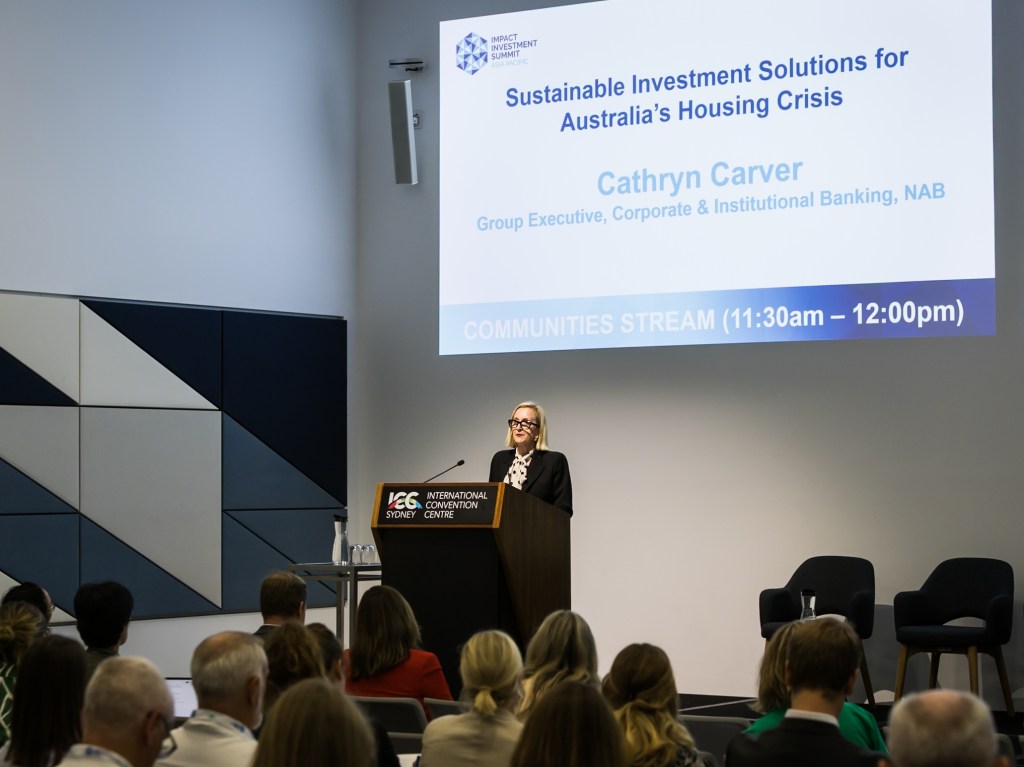NAB Foundation has launched an Impact Investing Fund (IIF), as announced by NAB Group Executive Corporate & Institutional Banking, Cathryn Carver, at the Impact Investment Summit Asia Pacific in Sydney last week.
The new $50 million IIF — part of NAB Foundation’s $170 million total corpus — seeks to invest in opportunities that intentionally generate a positive and measurable social and environmental impact alongside appropriate risk-adjusted financial returns.
Carver unveiled the IIF while speaking at the Summit’s Communities – Social Infrastructure and Inclusion stream. She also took the opportunity to share her views on how to tackle Australia’s housing crisis, the affordable housing landscape and the urgent need for sustainable solutions.

A new Impact Investing Fund
The NAB Foundation has allocated $25 million of its total capital into the IIF, with $10 million already invested, and aspires to allocate up to $50 million by October 2026.
“Directing capital to aligned impact investments opens up new ways for the Foundation to create positive and lasting change,” Carver said.
JBWere will manage the Fund and it will be guided by a specialist committee chaired by Ben Smith, Head of Impact Investing at Paul Ramsay Foundation. The committee will work closely with JBWere and other specialists to identify and conduct due diligence on impact investment options, providing the governance framework to guide investment decisions, and further the growth of the market in Australia.
Investments will focus on NAB’s sustainability pillars: Indigenous Economic Advancement; Climate Transition; and Social and Affordable Housing.
Carver stressed that IIF is a true impact fund that will invest in opportunities that intentionally generate a positive and measurable social and environmental impact alongside financial returns.
Carver also noted that the new NAB Impact Investment Fund is just one of the ways NAB is bringing its various tools together to maximise its impact – through lending, philanthropic, social and political, and investment muscle.
This includes lending a further $6 billion of financing into the affordable housing sector by 2029, as well as exploring innovative financing solutions, including social and sustainability bonds, to increase capital flows for community housing providers.
Affordable Housing: an acute and urgent challenge
“This crisis point we’ve reached is the price of inaction,” said Carver. “We cannot continue to deny — or just keep talking about — the systemic issues that are stifling solutions.”
“The only way we’ll move the dial is if we drive down project costs, eliminate process roadblocks, address labour challenges and create innovative financing models that attract big investments and accelerate large scale projects. To get there we need the whole system working together, and we need to get into action immediately.”
What’s needed is systematic change and sustainable investment solutions.
Carver acknowledged that while small amounts of progress are being made in some areas, it’s nowhere near enough to tackle the housing crisis — despite the efforts of governments and some of NAB’s clients, such as Assemble, Local: Residential and Junction Australia.
“For the most part, we’re only channelling funds into far ends of the capital structure,” said Carver.
“Housing Australia and commercial banks are providing the senior debt, while government support, in limited cases, is topping up returns to attract what little equity might be available.
“Though for often asset rich but cash flow poor community housing providers, their equity layer is often almost non-existent, leaving ‘a gaping hole’ in the middle.”
What’s the solution?
So then, how can we reimagine funding structures to consistently and effectively crowd capital into the Mezzanine layer? And, how can we make these investment solutions sustainable?
The solution, says Carver, is a combination of:
- Private capital investment, such as NAB Foundation’s new IIF
- Patient capital, especially via superannuation funds (investing just 0.5% of industry super assets in social and affordable housing could see more than $15bn invested and around 100,000 homes built by 2030).
- The investment of intellectual capital and sharing knowledge, particularly with charitable and not-for-profit partners.
Carver ended her speech with the following:
“When you also consider how much human capital is spent by governments designing the $10 billion Housing Australia Future Fund (HAFF) and other schemes, by developers, by community housing providers, fund managers, real estate investors, and all the other parties, it’s mind boggling that we are yet to find any breakthrough solutions to address the housing crisis.
“We need to stop just talking about it. We need to take action.
“To get consistency and alignment in government policies to enable market returns and to give large institutional investors the confidence to invest.
“To make planning processes faster and simpler, and to accelerate large-scale developments.
“And to drive down costs and create innovative funding models that are less dependent on government subsidies, and more sustainable over the lifecycle of a development.
“And we need this to happen now. Because if we’ve learned anything over the past few years, it’s that unless we can make meaning changes the issue is only going to get worse.
“And by default, we become part of the problem.”
Read Carver’s full speech announcing the NAB Impact Investment Fund here: Sustainable investment solutions for Australia’s housing crisis: Cathryn Carver addresses the Impact Investment Summit Asia Pacific.
NAB Foundation
NAB Foundation is a registered charity that uses philanthropy, social investment and in-kind support to fund social and environmental progress in Australian communities served by NAB.
The NAB Foundation aims to help tackle social and environmental challenges by funding the people and communities who make a real difference. It has a focus on natural disaster resilience, climate transition, First Nations economic advancement and affordable housing.

